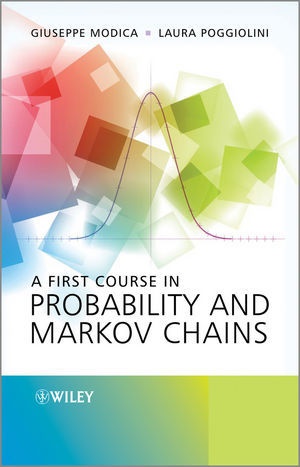Read more
Informationen zum Autor Giuseppe Modica and Laura Poggiolini, Dipartimento di Sistemi e Informatica, Università di Firenze, Italy Klappentext Provides an introduction to basic structures of probability with a view towards applications in information technologyA First Course in Probability and Markov Chains presents an introduction to the basic elements in probability and focuses on two main areas. The first part explores notions and structures in probability, including combinatorics, probability measures, probability distributions, conditional probability, inclusion-exclusion formulas, random variables, dispersion indexes, independent random variables as well as weak and strong laws of large numbers and central limit theorem. In the second part of the book, focus is given to Discrete Time Discrete Markov Chains which is addressed together with an introduction to Poisson processes and Continuous Time Discrete Markov Chains. This book also looks at making use of measure theory notations that unify all the presentation, in particular avoiding the separate treatment of continuous and discrete distributions.A First Course in Probability and Markov Chains:* Presents the basic elements of probability.* Explores elementary probability with combinatorics, uniform probability, the inclusion-exclusion principle, independence and convergence of random variables.* Features applications of Law of Large Numbers.* Introduces Bernoulli and Poisson processes as well as discrete and continuous time Markov Chains with discrete states.* Includes illustrations and examples throughout, along with solutions to problems featured in this book.The authors present a unified and comprehensive overview of probability and Markov Chains aimed at educating engineers working with probability and statistics as well as advanced undergraduate students in sciences and engineering with a basic background in mathematical analysis and linear algebra. Zusammenfassung Provides an introduction to basic structures of probability with a view towards applications in information technology A First Course in Probability and Markov Chains presents an introduction to the basic elements in probability and focuses on two main areas. Inhaltsverzeichnis Preface xi 1 Combinatorics 1 1.1 Binomial coefficients 1 1.1.1 Pascal triangle 1 1.1.2 Some properties of binomial coefficients 2 1.1.3 Generalized binomial coefficients and binomial series 3 1.1.4 Inversion formulas 4 1.1.5 Exercises 6 1.2 Sets, permutations and functions 8 1.2.1 Sets 8 1.2.2 Permutations 8 1.2.3 Multisets 10 1.2.4 Lists and functions 11 1.2.5 Injective functions 12 1.2.6 Monotone increasing functions 12 1.2.7 Monotone nondecreasing functions 13 1.2.8 Surjective functions 14 1.2.9 Exercises 16 1.3 Drawings 16 1.3.1 Ordered drawings 16 1.3.2 Simple drawings 17 1.3.3 Multiplicative property of drawings 17 1.3.4 Exercises 18 1.4 Grouping 19 1.4.1 Collocations of pairwise different objects 19 1.4.2 Collocations of identical objects 22 1.4.3 Multiplicative property 23 1.4.4 Collocations in statistical physics 24 1.4.5 Exercises 24 2 Probability measures 27 2.1 Elementary probability 28 2.1.1 Exercises 29 2.2 Basic facts 33 2.2.1 Events 34 2.2.2 Probability measures 36 2.2.3 Continuity of measures 37 2.2.4 Integral with respect to a measure 39 2.2.5 Probabilities on finite and denumerable sets 40 2.2.6 Probabilities on denumerable sets 42 2.2.7 Probabilities on uncountable sets 44 2.2.8 Exercises 46 2.3 Conditional probability 51 2.3.1 Definition 51 2.3.2 Bayes formula 52 2.3.3 Exercises 54 2.4 Inclusion-exclusion ...

